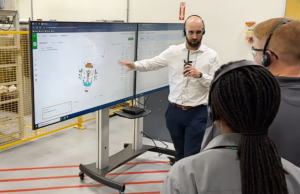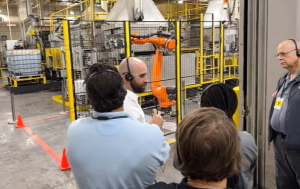Introduction
In the heart of Fort Mill, South Carolina, a beacon of innovation and sustainability shines brightly. Schaeffler, a renowned motion technology company with a legacy spanning 75 years, recently opened its doors to some of their peer manufacturers across the Carolinas. The occasion was the September OpExChange plant tour, an event that brought together representatives from twenty-two manufacturing companies. This collaborative visit, hosted at Schaeffler’s Fort Mill 1 plant, was more than just a routine factory visit; it was an immersion into Schaeffler’s culture of digital innovation.
Three overarching themes resonated during this visit: Digitalization, Innovation, and Sustainability. Ben Pfahl, Vice-President, CIO for Schaeffler Americas, set the tone for the day as he welcomed the eager participants. What was immediately evident was that Schaeffler has evolved far beyond its reputation as a Tier 1 automotive supplier. With a resolute commitment to e-mobility and electronic devices, Ben articulated Schaeffler’s proactive approach: “Schaeffler did not take a passive role in e-mobility. Over a decade ago, we decided that we did not only want to get on the bus, but we wanted to help drive the bus.”
The guiding mantra for Schaeffler today is succinct and powerful: “We pioneer motion.” With three distinct divisions – Automotive Technologies, Automotive Aftermarket, and Industrial – Schaeffler is on a path to redefine the boundaries of motion technology. Ben highlighted the growing synergy and collaboration between these divisions, driven by a shared focus on Smart technology and advancing e-mobility. Motion serves as the common thread binding their six product families: Sustain Motion, Energize Motion, Drive Motion, Generate Motion, Transmit Motion, and Guide Motion.
Ben’s emphasis on innovation was not mere rhetoric. In the year 2022 alone, Schaeffler registered an impressive 1,250 patents, a testament to their unwavering dedication to pushing the boundaries of what’s possible in motion technology. With each patent, Schaeffler not only propels itself forward but also the entire industry, setting new standards and creating opportunities for the future.
Ben added that Schaeffler began their digital journey in manufacturing about five years ago. “We started some projects. We had some successes, and we had some failures along the way.” They learned from these failures. This is part of the innovation process. Ben stated that they are at a point now where “Digitalization is the glue, the string that ties everything together.”
Fort Mill Plant 1
Ryan Raquet, the plant manager leading the operations at the plant, assumed control and provided the visitors with a comprehensive bird’s-eye view of the Fort Mill 1 plant. This facility is an integral part of Schaeffler’s Fort Mill campus, which encompasses Fort Mill Plant 2 and the corporate headquarters for the Americas. With its roots dating back to 1985, the plant has undergone remarkable transformations, nearly tripling in size through two major expansions.
The primary focus of Fort Mill Plant 1 revolves around the production of thrust bearings, a critical component that finds its way into an array of applications. A majority of their production serves the automotive sector, where they play a pivotal role in automatic transmissions, torque converters, and electronic parking brakes. Additionally, the plant’s versatility extends to serving various industrial customers, with their bearings finding homes in products ranging from snowmobiles to lawnmowers.
What sets Fort Mill Plant 1 apart is its impressive degree of vertical integration. Here, a seamless integration of processes, encompassing stamping, washing, heat treatment, finishing, and assembly, comes together cohesively within a single facility. Perhaps even more remarkable is that all assembly and inspection equipment employed in these processes are meticulously designed and crafted by Schaeffler’s talented engineers.
One of the plant’s crowning jewels is its machine shop, where precision tooling is conceived and birthed. The equipment within this group possesses the capability to manufacture tools with tolerances finer than 20 microns. Ryan provided an analogous visualization to this measurement – this is less than the width of a human hair. The resultant tooling is the foundation of quality and repeatability in their stamping operations.
The factory floor at Fort Mill Plant 1 is characterized by a logical and well-structured workflow. Operations progress methodically from left to right, encompassing critical phases such as stamping, washing, heat treatment, assembly, and shipping. This orchestrated sequence ensures efficiency and consistency throughout the production process.
Digitalization is the Glue
The OpExChange visit to Schaeffler’s Fort Mill 1 plant was not merely an occasion for OpExChange peers to witness manufacturing in action. It was an opportunity to explore Schaeffler’s progress in the realm of Digitalization, a subject of immense interest to every OpExChange member. Jacob Vandesande, the Manager of Digitalization and Operations IT for Schaeffler Americas, illuminated the roadmap for Digitalization that Schaeffler and the Fort Mill 1 plant are traversing, revealing a comprehensive strategy that seamlessly integrates digitalization into their continuous improvement program.
Jacob underscored that Digitalization is not a standalone initiative; instead, it’s now a potent tool within their continuous improvement toolbox. Their roadmap revolves around two core technological pillars: connectivity and automation. Connectivity involves the seamless integration of machines and the extraction of valuable data, opening doors to a multitude of digitalization applications. Automation, on the other hand, focuses on optimizing the workforce, reducing non-value-added activities, and enhancing material supply and handling.
Over the past five years, Schaeffler has embraced an array of digital solutions across the Americas. These solutions have been sourced from internal development, third-party providers, and a combination of both. From an automation perspective, their journey embarked earnestly in 2022 with the introduction of an automated floor scrubber and subsequently with autonomous mobile robots. Notably, three Bosch Rexroth active shuttles are employed to automate material goods delivery within the facility, operating around the clock with a respectable payback period of approximately two years. More recently, an industrial robot was introduced for loading furnaces, streamlining a task that would typically involve manual loading into a 900-degree furnace. This not only boosts efficiency but also enhances workplace safety, with an anticipated payback period of 1.7 years.
Schaeffler’s ambitious automation agenda extends to include further projects in the pipeline, all aimed at automating various aspects of their operations, including the loading of additional furnaces.
On the connectivity front, Schaeffler has witnessed a multitude of applications unfold in recent years. Jacob shed light on two prominent examples: production reporting and condition monitoring of production equipment. Production and project reporting have transitioned into a customized manufacturing execution system (MES). Digital displays across all process areas provide real-time information, including hourly tracking and overall equipment effectiveness (OEE) percentages. These displays also facilitate digital reporting of safety, quality, productivity, and task execution.
The implementation of condition monitoring through their internally developed sensors, known as OPTIME, is another significant stride. These sensors log vibration and temperature, with around 40 deployed thus far at the Fort Mill 1 plant and a staggering 4,900 across the corporation. Remarkably, this initiative has already resulted in approximately $100,000 in savings by mitigating downtime-related costs. Schaeffler has now made these loggers, along with an automated lubrication device, available to other manufacturers through their Lifetime Solutions group.
Beyond these achievements, Schaeffler has deployed various other Industry 4.0 applications, including the use of HoloLens’s for augmented reality, artificial intelligence for spare parts identification, and 3D printing for creating smaller tooling and spare parts.
A Walk Through the Fort Mill Plant
Following the insightful presentations by the Schaeffler team, the OpExChange team transitioned into smaller groups for a guided tour of the facility. Equipped with headsets, the visitors began the interactive tour, tracking the value stream of a bearing from its inception in tool creation to its culmination in the final assembly.
The tooling shop at the beginning of the tour made an indelible impression on the group. Plant Manager Ryan Raquet discussed the two distinct categories of tools that Schaeffler manufactures for their presses: Modular tools necessitating disassembly and reconstruction between each production run and progressive tools tailored for higher volume, repetitive production.
Within the tooling group, Schaeffler harnesses the power of two internally developed digital applications. Ditos utilizes 3D CAD data to generate digital work instructions for the tool makers. Complementing this is TIM (Tooling Improvement Monitor), another proprietary application that meticulously tracks the history of each tool. It monitors the number of strokes and maintains a comprehensive history while also issuing proactive maintenance alerts based on stroke count.
Ryan underscored an exemplary sustainability initiative, referred to as “part-in-part,” aimed at reducing waste and costs. The residual waste is then routed for recycling through Nucor Steel in Darlington, a fellow OpExChange member.
A tour highlight unfolded in the heat treat department, where a recently introduced KUKA robot demonstrated another automation success.
Further sophistication in automation was showcased within the assembly department, featuring the “Visual Inspection Engine.” This cutting-edge system conducts 100% inspection of all washers, employing a spectrum of sequential technologies such as automated visual inspection for anomaly detection, eddy current testing, laser flatness checks, and diameter verification.
Ryan emphasized the importance of this intensive inspection, noting that even a single mark on a bearing can potentially lead to customer complaints. As with all Schaeffler assembly and inspection equipment, the innovation behind this system was meticulously crafted by Schaeffler’s innovative engineers, exemplifying their commitment to precision and excellence.
Schaeffler Digitalization Recommendations – Get Started!
At the conclusion of the plant tour, the group reconvened in a conference room for the customary OpExChange “Plus/Delta” session – an interactive dialogue where peer companies shared valuable feedback on ideas that they could potentially implement in their own operations. Moreover, they offered insightful suggestions for Schaeffler’s future continuous improvement initiatives. The collective sentiment among the group was one of profound admiration for the Schaeffler innovations witnessed during the plant tour, sparking engaging discussions. In the realm of digitalization, Ben Pfahl offered his insights and recommendations to his peers. He advised, “If any of you are starting your digital journey, my suggestion to you is to start some projects. Do some pilots … see what is going to work and what is not going to work. Don’t be afraid to fail.” Additionally, he encouraged active participation in forums like the OpExChange, emphasizing the importance of learning from others’ experiences and insights.
About Schaeffler
The Schaeffler Group has been driving forward groundbreaking inventions and developments in the field of motion technology for over 75 years. With innovative technologies, products, and services for electric mobility, CO₂-efficient drives, chassis solutions, Industry 4.0, digitalization, and renewable energies, the company is a reliable partner for making motion more efficient, intelligent, and sustainable – over the entire life cycle. The motion technology company manufactures high-precision components and systems for drive train and chassis applications as well as rolling and plain bearing solutions for a large number of industrial applications.
The Schaeffler Group generated sales of EUR 15.8 billion in 2022. With around 84,000 employees, the Schaeffler Group is one of the world’s largest family-owned companies. With more than 1,250 patent applications in 2022, Schaeffler is Germany’s fourth most innovative company according to the DPMA (German Patent and Trademark Office).
About OpExChange
The OpExChange, sponsored by the South Carolina Manufacturing Extension Partnership, is a peer-to-peer network of manufacturers and distributors in South Carolina known for generating success for members through benchmarking and best practice sharing. Member companies host events and share practical examples of industrial automation, lean manufacturing improvements, and leadership development. It is an invaluable resource to South Carolina companies that provides access to others who are on similar improvement journeys. If your company is interested in participating in this collaborative effort to improve both the competitiveness of your operation and South Carolina, contact Mike Demos (Mike@OpExChange.com). More information and upcoming plant visits are available on the OpExChange website www.OpExChange.com.




Be the first to comment on "Exploring Digitalization: Inside Schaeffler’s Fort Mill Facility"